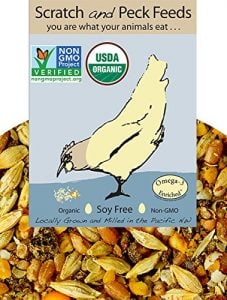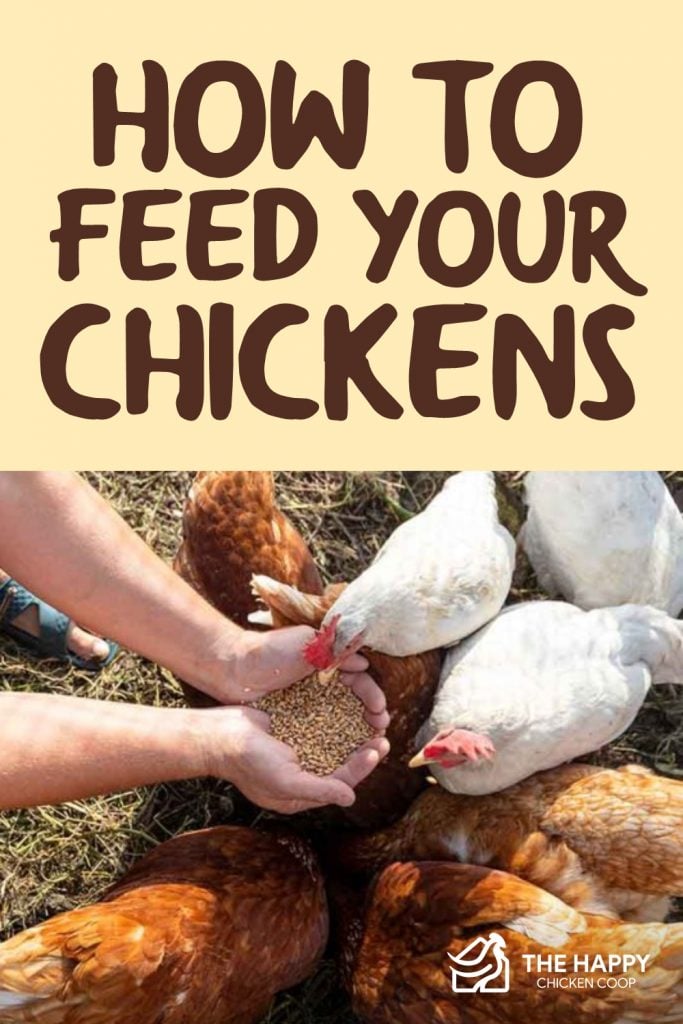How Long Do You Feed Chickens Starter Grower Food
How to feed your chickens might not be something which you pay too much attention to, but did you know that seventy percent of the cost of raising chickens goes toward feed?
Therefore it stands to reason that you need to pay attention to what you feed your birds.
No one chicken is the same as each breed all require slightly different mixes of nutrition, as do laying birds or meat birds.
Let's start at the beginning and work our way through the ages, types of chicken and look at exactly how you should be feeding your chickens.

Our Favorite Pick for Chicken Feed

Scratch and Peck Feeds Naturally Free Organic Layer Feed
- Scratch and Peck's layers feed is one of my hens' favorite
- Non-GMO, soy-free and crucially its USDA certified organic
- Milled right here in the US
- Egg yolks turned a deeper golden orange color and are bursting with flavor
See Price on Amazon
Chicken Nutritional Requirements
As with humans and other mammals, chickens need a slightly different nutritional input as they are growing.
We have set out the suggested feed requirements very briefly below.
Young chicks need more protein in order to grow rapidly during their first few weeks of life.
Please note that most, if not all, feed producers have a table on the back of the feed sack to give guidelines for appropriate feeds.

How to Feed Your Broiler Chicks
Broiler (a chicken breed for meat) chicks are required to put weight on fast, ready for slaughter at around fourteen weeks of age.
Their feed is high in protein to enable the chick to develop and put weight on rapidly.
For the first three weeks, they are fed a broiler starter, which is 22% protein. At four weeks old they are changed to finisher feed which contains 19% protein.
How to Feed Your Layer Chicks

Kaytee Chicken Starter Grower Crumble
- This is our favorite feed for chicks. It contains Probiotics and key essential amino acids
- The package is resalable to prevent feed from going stale
- Your chicks should be fed this feed from when they hatch until they are six weeks old
See Price on Amazon
Layer chicks get chick starter feed up to six weeks of age- chick starter feed is normally around 20% protein. They still need higher protein but are growing less rapidly than the broiler chicks.
At six weeks they are then changed over to grower feed which is 17-18% protein until about twenty weeks. A high level of protein is required at this age for the bird to fully develop into a good layer.
At twenty weeks or so, they can be changed over to layer ration which is 16 -18% protein. At this age, your pullets should be thinking about laying some eggs for you! My girls will then stay on layers ration permanently.
It is very important that the correct feed is given to your layers since the calcium requirements are different from chick to pullet!
You can feed older birds higher protein feed and offer up extra calcium by way of ground oyster shells or crushed eggshells, but you should not give younger birds' layer ration.
Layer ration contains a higher level of calcium than they need and too much calcium at a young age can lead to kidney failure.
As you can see, from the perspective of protein and calcium requirements alone, it would be a daunting task to mix your own feed.
Chickens require thirty-eight separate dietary nutrients to be in the best of health!

Feed companies have animal health nutritionists to work out formulae for any number of animals at any given age.
Poultry is no exception. The feed they produce has been scientifically formulated, is complete nutrition, and is reasonably priced to give you the best 'bang for your buck'.
How Often Should I Feed My Birds?
This is really a personal preference in most cases, and there are two schools of thought:
- Free choice
- Fixed feeding
If you have a busy schedule throughout the day, the free choice would probably be best. If you are available at set times of the day, you could easily go with fixed feeding.
Free Choice Feeding
Our Pick

Grandpa's Feeders Automatic Chicken Feeder
- My favorite chicken feeder
- On-demand feeder means your hens will have access to feed all day round, which ensures optimal laying and healthy chickens
- It also helps to eliminate feed spillage, keeps pests away, and as a result means you save on feed cost
Check The Price
Benefits:
- All birds get a chance to eat. Bully birds can't 'guard' the feeders all day long.
- They can eat little and frequently, this is more natural for them.
- Less work for the keeper! Top up the feeders once a day.
Disadvantages:
- Rodents can get access also.
- If the feed is outside, it can get wet and moldy.
Fixed Feeding Time
Benefits:
- Less wastage for rodents etc.
- Birds will not overeat.
Disadvantages:
- Squabbling over feeders, some birds getting bullied.
- Somewhat inflexible, need to be consistent with times.
I feed my flock as free choice. This way I find it more flexible for me. I top off the feeders in the evening so they have plenty to eat when they wake up.
I also have a better idea of when I need to buy more feed.

If you are raising broilers, they will need to have access to food twenty-four hours a day in order to put weight on. They will, of course, need lights to eat by.
Types of Feed

Scratch and Peck Feeds Naturally Free Organic Layer Feed
- Scratch and Peck's layers feed is one of my hens' favorite
- Non-GMO, soy-free and crucially its USDA certified organic
- Milled right here in the US
- Egg yolks turned a deeper golden orange color and are bursting with flavor
See Price on Amazon
Organic Feed
Organic feed is more expensive and usually a bit more difficult to find.
If however, you want to be sure that your birds do not have access to GMO feed, or you are going to be certified as an organic farm, you need to use organic feed.
Organic feed does not contain antibiotics, animal byproducts, persistent pesticides, or chemical fertilizers. Hormones are prohibited by federal regulations.
Medicated Feed or Non-Medicated
The feed companies also offer medicated or non-medicated starters for chicks.
The medicated starter is treated with amprolium and sometimes antibiotics, to help as a preventative against coccidiosis.
Note: If your chicks have been vaccinated against coccidiosis, then you should not give them a medicated starter.

On a personal note, I do not use medicated feed. My chicks are kept separate in clean quarters, so the risk of coccidiosis is small.
They are introduced to the 'outside world' slowly so that they can develop their own immunity to coccidiosis.
Fermented Feed
Many chicken keepers feed their flock fermented feed. What is that, I hear you ask?
Any feed or grain that you can feed to your hens, can be fermented.
In its simplest form, you add water, a little apple cider vinegar, and around ¼ teaspoon of yeast to the feed and store it in a suitable container (not metal).
Over a period of about 3-4 days, your feed will smell vaguely like a sourdough. At this stage, it is ready for your chickens to eat.
Proponents of fermented feed say that it is more cost-effective and a bag of feed stretches much further.
Why is this so? The fermentation process of grains actually releases many of the 'locked in' nutrients of grains. Seeds have a tough outer coating so that they can survive in a hostile environment until the time is right to germinate.
Fermenting tricks the seeds into giving up they're locked in goodness!
We haven't tried fermented food here yet, but it's definitely something that we want to try next spring.
Other Nutrition Requirements
You are going to need to give your birds a couple of things in addition to regular feed.
- Calcium: In the form of crushed oyster shell, available from the feed store. Calcium assists the hen in laying a hard-shelled egg, softshells are indicative of a lack of calcium. You can also feed eggshells back to the girls. I 'cook' my eggshells in a low heat oven for about thirty minutes or so. This helps to destroy any salmonella that may be lurking in the shell. Crush them up and add to the oyster shell feeder.
- Grit: You can buy grit from the feed store. They also make chick-sized grit as well. Grit is used by the hen to grind down their food.
- Greens: If your hens are pastured they will be supplied all the greens they need for a complete diet. If you are unable to pasture them, cabbage leaves, kale, broccoli, etc. all supply the necessary green nutrition.
- Kitchen scraps: Squash seeds, tomatoes, melon rind, etc. Make sure you read our previous blog post, stop killing your chickens, where we cover many of the things chickens should not eat.
How to Feed Your Chickens & Choosing the Right Feeder
All of this is a moot point if you don't have the right feeders for your chickens because a bad feeder will cause wasted feed and the spread of disease amongst your flock.
As you know, chickens love to roost on everything…even on top of feeders, if possible.
And if you've seen the area under their roosts you know that the droppings will pile up.
So your feeder must prevent chickens from doing things like roosting above the feed, dust bathing in it, or tossing it all over the coop.
Specific poultry feeders are your best bet because they will discourage waste and keep feed clean.
Look for feeders that have moving parts to prevent roosting or direct access to feed as well as feeders that have small access areas which prevent chickens from scratching at their feed, and throwing it everywhere it doesn't belong.
How To Geed Your Chickens Our Final Thoughts
As you can see, there are several different choices for your birds out there. As long as they are healthy and active there really isn't a 'right or wrong in your choice of feed.
What works for me may not work as well for you.
I will be trying out fermented feed over the coming cold, northeast winter months. I will also be keeping notes as I go, so I hope to share those results with you come to springtime!
Let us know in the comments section below, what are your top tips for feeding your chickens?
Want To Share This…

Source: https://www.thehappychickencoop.com/how-to-feed-your-chickens/
0 Response to "How Long Do You Feed Chickens Starter Grower Food"
Post a Comment